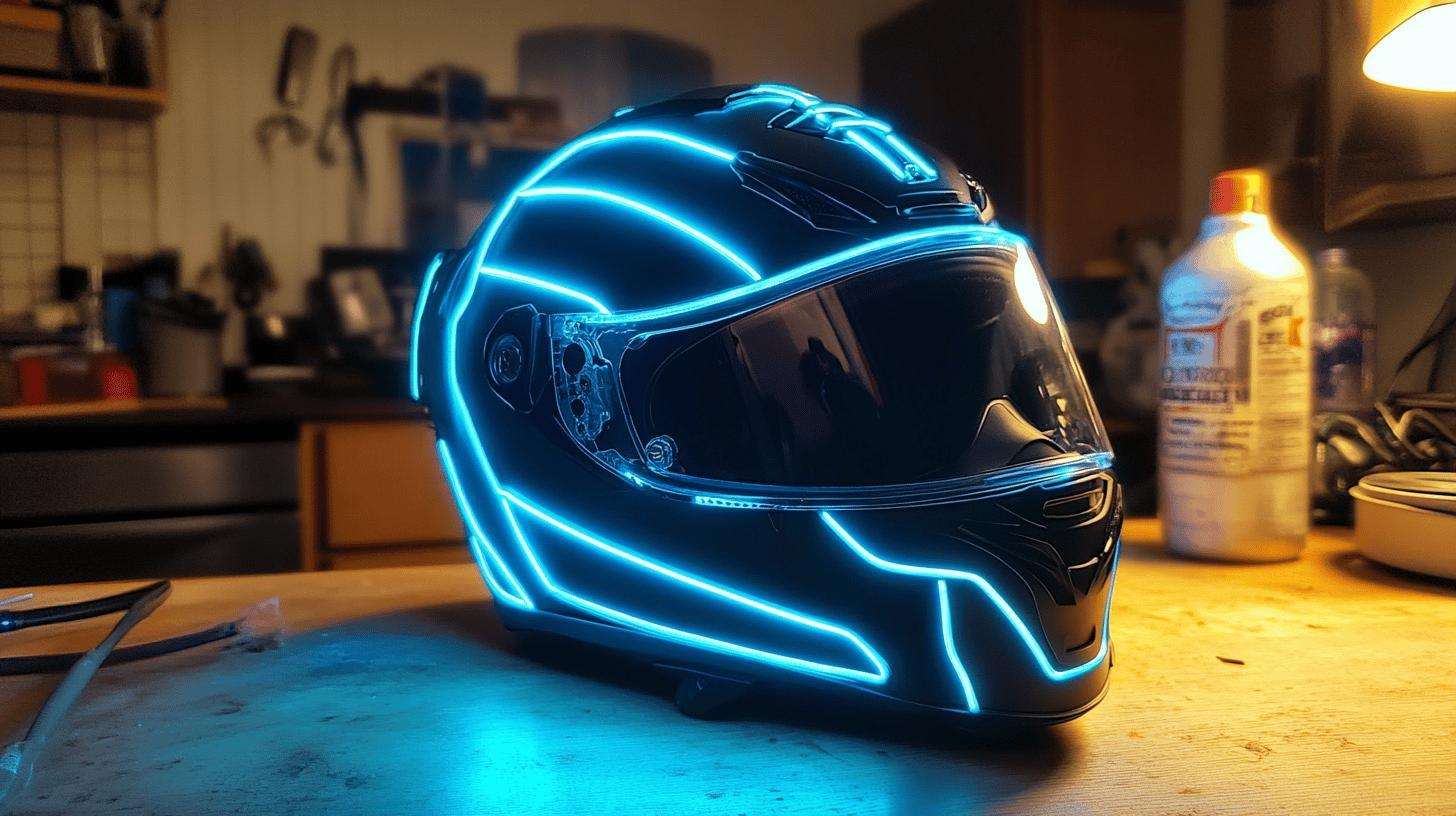When night falls or fog rolls in, is your helmet color working for or against your visibility on the road? The color of a motorcycle helmet can dramatically impact how easily others on the road see a rider.
The wrong color choice might mean blending into the background, while the right color can make a rider more apparent, potentially preventing accidents.
This article explores which helmet colors, from bright neon shades to classic whites, stand out best across various riding environments, ensuring not just style but also safety for motorcyclists.
Why Helmet Color Matters for Visibility

Color significantly impacts motorcycle helmet visibility by determining how well a rider stands out on the road. Bright colors such as white, neon yellow, and orange are the most visible, providing a stark contrast against various backgrounds.
This enhanced visibility can make a critical difference in safety, helping other road users notice the rider more quickly and reducing the likelihood of accidents.
The impact of helmet color on safety is profound. Bright helmets, like those in neon yellow, orange, and white, are more effective in catching attention due to their high contrast and reflective properties.
These colors are especially beneficial in low-light environments or adverse weather conditions where visibility might otherwise be compromised. Conversely, darker shades such as black or dark blue tend to blend into shadows and urban environments, which can significantly reduce a rider's visibility.
This diminished visibility increases the risk of accidents, as other drivers may not be able to spot the rider in time.
-
White: Highest contrast with most backgrounds.
-
Neon Yellow: Grabs attention and stands out.
-
Orange: Effective in low light, similar to hazard signs.
- Bright Red: Eye-catching and noticeable.
Choosing a helmet color is not just about personal preference; it plays a pivotal role in rider safety, depending on the environment. Urban areas with busy backgrounds benefit from high-contrast colors, while rural settings with natural backdrops require colors that stand out against the greenery or earthy tones. Thus, selecting a visible helmet color is essential to maintaining safety across different riding environments.
Bright vs Dark Helmet Colors: Safety Implications

The visibility of a motorcycle helmet is critically influenced by its color. Bright helmets, such as neon yellow, orange, and white, are known for their high visibility. In contrast, darker helmets like black and blue are less noticeable on the road, potentially posing a safety risk unless supplemented with reflective materials.
Bright Helmet Colors
Bright colors enhance a rider's visibility, making them more noticeable to other road users. Neon yellow, orange, and white helmets are particularly effective due to their ability to stand out against most backgrounds. These colors act similarly to hazard signs, drawing attention and reducing the risk of being overlooked by other drivers.
-
High Contrast: Offers a stark difference from typical road environments, increasing recognition.
-
Attention-Grabbing: Colors like neon yellow and orange naturally attract the eye, akin to warning signs.
-
Improved Visibility in Low Light: Bright colors remain visible even in dim conditions, such as at dusk or in cloudy weather.
Dark Helmet Colors
Dark helmets present challenges due to their tendency to blend with various environments. Black and blue helmets, while stylish, can fade into urban settings or shadows, diminishing a rider's visibility. To counteract this, adding reflective materials is necessary to enhance safety.
-
Low Visibility: More likely to be overlooked, especially in poorly lit conditions.
-
Blending with Backgrounds: Can merge into urban or naturally dark settings, reducing contrast.
-
Need for Additional Reflective Materials: Requires enhancements to achieve similar visibility levels to bright helmets.
Selecting bright helmet colors is paramount for optimal safety and visibility. Bright hues not only increase the likelihood of being seen but also communicate a visual cue to drivers, making it easier for them to react appropriately. Prioritizing brighter helmets can significantly enhance a rider's presence on the road, contributing to safer journeys.
Enhancing Helmet Visibility with Reflective Materials

Reflective materials play a crucial role in improving the visibility of motorcycle helmets. They work by reflecting light back to its source, effectively increasing the helmet's contrast against its surroundings. This is particularly beneficial for darker helmets, which may naturally blend into many backgrounds, posing a visibility challenge for riders.
Reflective stickers and panels are popular visibility enhancers for helmets. By strategically placing these materials on a helmet, a rider can significantly boost their presence on the road. These reflectors catch and bounce back light from headlights and streetlights, making the rider more noticeable, especially at night or in low-light conditions.
Adding LED helmet lights or high-beam lights can further enhance visibility. These dynamic visual cues not only improve detection by other road users but also provide an added layer of safety by creating movement that draws attention.
-
Increased Contrast: Reflective materials provide a stark contrast against darker helmet colors, improving visibility.
-
Enhanced Night Visibility: Reflectors catch light from headlights, making helmets more visible in the dark.
-
Improved Detection by Other Road Users: Reflective elements help ensure that riders are seen more quickly by drivers, reducing accident risks.
Using reflective materials does not compromise helmet safety, provided they are applied correctly. They offer a simple yet effective way to improve a rider's visibility without altering the helmet's structural integrity or protective capabilities. This approach allows riders to maintain personal style while prioritizing safety on the road.
Helmet Color and Weather Conditions: What to Consider

Weather conditions can greatly impact the visibility of motorcycle helmets. Factors like fog, rain, and bright sunlight alter how a helmet's color is perceived on the road, influencing a rider's safety. Consequently, choosing the right helmet color becomes crucial in ensuring optimal visibility under varying weather scenarios.
Fog and rain present challenges by diffusing light, making it harder for other drivers to spot riders. White and bright-colored helmets are particularly effective in these conditions as they reflect light better, maintaining a high level of visibility.
During bright sunlight, white helmets again prove advantageous by reflecting sunlight, reducing glare, and keeping the rider cooler. Conversely, darker helmets may absorb heat and light, potentially diminishing visibility. Riders in areas with frequent rain or fog should consider helmets with bright colors or reflective elements to enhance visibility and safety.
-
Visibility in Fog: Bright or white helmets stand out, cutting through mist and improving recognition.
-
Visibility in Bright Sunlight: White helmets reflect sunlight, reducing heat absorption and glare.
-
Visibility During Rain: Light colors and reflective materials help maintain visibility despite reduced light conditions.
When choosing a helmet color, riders should account for the typical weather conditions in their area. Opting for bright or reflective helmets in regions prone to adverse weather can significantly enhance safety by ensuring that they remain visible to other road users.
Practical Tips for Choosing the Most Visible Helmet Color

When choosing a motorcycle helmet, prioritizing safety over aesthetics is crucial. Visibility plays a significant role in ensuring rider safety on the road. Bright, high-visibility colors should be at the forefront of your decision-making process, as they increase the likelihood of being noticed by other road users, thereby reducing the risk of accidents.
High-visibility colors like fluorescent yellow and orange stand out due to their eye-catching nature. These colors are effective in grabbing attention and are similar to warning signs used in various safety contexts.
Neon yellow, for instance, is particularly noticeable and provides excellent contrast against many backgrounds. Orange helmets are also highly visible, especially in low-light conditions, making them an ideal choice for night riding or during overcast weather.
Solid white helmets, known for their high contrast and light-reflective qualities, offer another reliable option. They are highly effective in diverse environments, reflecting sunlight and ambient light to enhance visibility.
| Color | Visibility Benefit |
|---|---|
| White | High contrast, reflects light |
| Neon Yellow | Grabs attention, stands out |
| Orange | Effective in low light, similar to hazard signs |
Customization options, such as adding reflective stickers, can further enhance helmet visibility. This approach allows riders to maintain personal style without compromising on safety.
Reflective elements provide an added layer of visibility by catching and reflecting light, making it easier for other road users to spot you in various lighting conditions. Always consider both safety and style to ensure you choose a helmet that not only looks good but also keeps you safe on the road.
Final Words
Choosing the right helmet color significantly impacts visibility and safety. Bright colors like white, neon yellow, and orange stand out and improve a rider's visibility in various environments.
Reflective materials amplify this effect, especially in low-light conditions, without compromising helmet integrity. Weather considerations further underline the necessity of visible colors for safer riding.
Prioritizing high-visibility helmet colors ensures a safer and more confident riding experience. Always consider what color motorcycle helmet is most visible to enhance your protective gear choices.
FAQ
What color motorcycle helmet is most visible?
A white motorcycle helmet is most visible due to its high contrast. Bright colors like neon yellow, orange, and white significantly enhance visibility, making these colors the top choices for safety.
Should helmet color match the motorcycle?
Matching a helmet color to the motorcycle is a personal choice. Prioritizing visibility and safety with bright or contrasting colors is advisable to improve rider visibility on the road.
Does the color of a motorcycle helmet matter?
The color of a motorcycle helmet is crucial for visibility. Bright colors such as neon yellow, orange, and white boost safety by standing out against various backgrounds.
What is the best color for motorcycle visibility?
White is considered the best color for motorcycle visibility, providing sharp contrast in various environments. Neon yellow and orange are also effective in enhancing visibility, especially in low-light conditions.
Is there an important feature of motorcycle footwear to consider?
Motorcycle footwear should primarily provide ankle coverage and feature oil-resistant soles. These properties contribute to stability and safety while riding or stopping the motorcycle.

Ryan Thompson is a 35-year-old sport bike enthusiast known for his adventurous spirit. With years of weekend rides and exploring new roads, Ryan brings fresh insights and firsthand experience to ProtectiveGearz. His energetic approach and passion for the latest gear make him a trusted source for riders seeking up-to-date advice.



